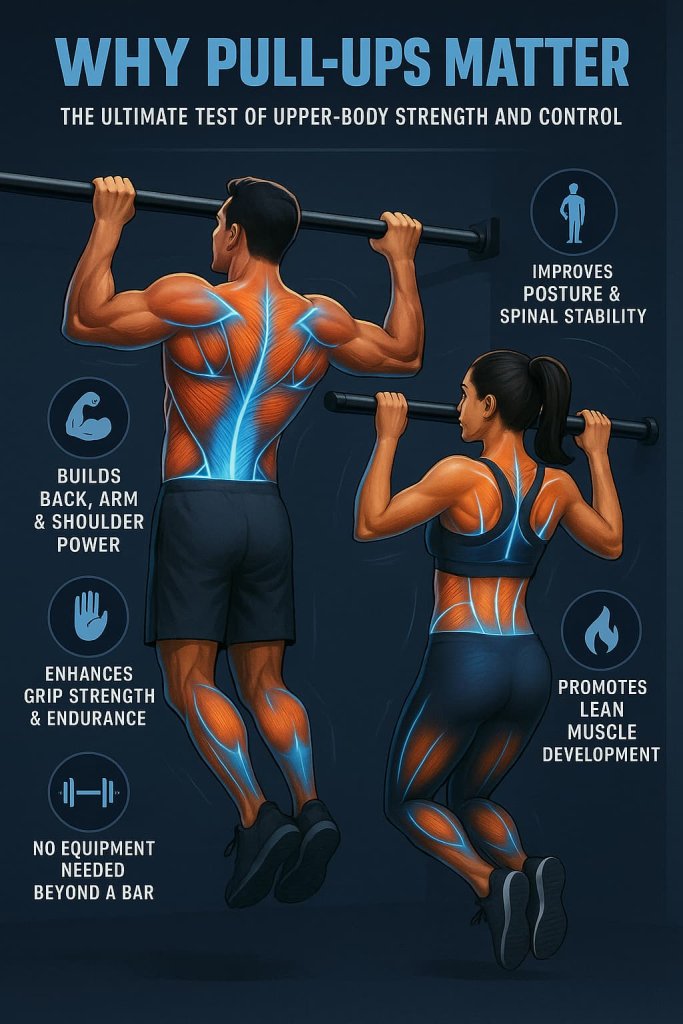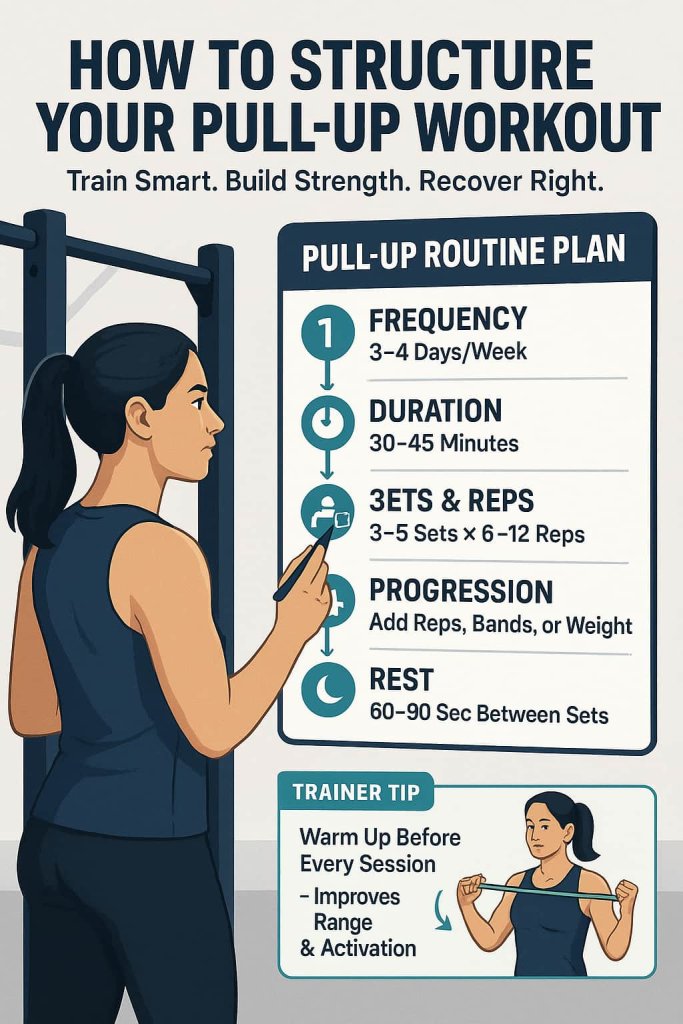Pull-ups are one of the most powerful exercises to build unstoppable upper-body strength fast.
They target your back, shoulders, arms, and core—helping you develop muscle, stability, and endurance all at once. Whether you’re a beginner working toward your first rep or an athlete refining advanced variations, mastering pull-ups is key for total upper-body control and strength.

Understanding proper pull-up progressions and techniques prevents shoulder strain and accelerates results. In this guide, you’ll learn the 10 best pull-up workouts (from beginner to advanced), training frequency, and expert form tips.
Why Pull-Ups Matter
Pull-ups are a compound, bodyweight movement that engages nearly every muscle in the upper body.
According to Healthline (2025), they strengthen the latissimus dorsi, biceps, rhomboids, trapezius, and core stabilizers, while improving posture and grip endurance.

Key Benefits:
- Builds back, arm, and shoulder strength simultaneously
- Improves posture and spinal stability
- Enhances grip strength and pulling endurance
- Promotes lean muscle development
- Requires no equipment beyond a pull-up bar
EMG research shows pull-ups produce high latissimus dorsi activation and robust involvement of the upper-back and arm muscles—often comparable to or higher than several pulldown and row variations.
How to Structure Your Pull-Up Workout

Frequency: 3–4 times per week
Session Length: 30–45 minutes
Sets & Reps: 3–5 sets of 6–12 reps (adjust with bands or weight)
Rest: 60–90 seconds between sets
Progression: Add reps, resistance, or advanced variations weekly
Trainer Tip: Always warm up shoulders and lats with light mobility work and band pull-aparts before your first pull-up.
10 Best Pull-Up Workouts
These 10 pull-up variations target every major muscle in your upper body — from your lats and biceps to your core and grip. Mix 3–4 of them per session to build balanced strength, endurance, and control on the bar.
1. Standard Pull-Up
Why it works:
The standard pull-up is the gold standard for upper-body strength and muscular coordination. It primarily targets the latissimus dorsi (your broad back muscles), while also engaging the traps, rhomboids, biceps, and core. Because it’s a closed-chain, compound movement, it recruits multiple muscle groups simultaneously, improving not only strength but also grip endurance and scapular control.
Muscles worked: Lats, traps, rhomboids, rear deltoids, biceps, forearms, and core stabilizers
How to do it:
- Grab the bar with an overhand grip slightly wider than shoulder-width.
- Engage your core and retract your shoulder blades (“pack” them down).
- Pull your chest up toward the bar by driving your elbows down and back.
- Keep your chin just above the bar, pause briefly, then lower slowly for 3–4 seconds.
- Perform 3–5 sets of 6–12 controlled reps.
Trainer Tip:
Visualize pulling the bar down to your chest rather than pulling your body up—this mental cue helps activate your lats more effectively. Avoid swinging or kipping, which shifts load to momentum instead of muscle engagement.
2. Chin-Up
Why it works:
Chin-ups use a supinated (palms-facing-you) grip, which increases biceps and chest involvement. This grip also shortens the range of motion slightly, allowing greater load and smoother movement for beginners.
Muscles worked: Biceps, lats, pecs, forearms, and anterior deltoids
How to do it:
- Grip the bar shoulder-width apart, palms facing toward you.
- Keep your chest tall and engage your core.
- Pull your body until your chin clears the bar.
- Pause at the top, then lower slowly to full arm extension.
- Repeat for 8–12 reps.
Trainer Tip:
If you struggle to complete a rep, use a resistance band or partner assistance. Focus on maintaining a straight line from head to hips to engage your back evenly rather than relying solely on arms.
3. Negative Pull-Ups
Why it works:
Negative pull-ups focus on eccentric strength — the controlled lowering phase. Eccentric contractions create more microtears in muscle fibers, which leads to greater hypertrophy and strength adaptation. This makes them an essential step toward unassisted pull-ups.
Muscles worked: Lats, biceps, forearms, and core
How to do it:
- Stand on a bench or jump up until your chin is above the bar.
- Slowly lower your body down in 3–6 seconds until your arms are fully extended.
- Step back up and repeat.
- Perform 5–8 reps for 3–4 sets.
Trainer Tip:
The slower you lower, the better the result. Use a timer to control your descent speed. Negatives are best at the end of a workout when your muscles are warm and fully activated.
4. Banded-Assisted Pull-Up
Why it works:
This variation reduces effective bodyweight, making pull-ups more accessible while maintaining proper form. The elastic band provides variable resistance — it supports you more at the bottom (when you’re weakest) and less at the top (when you’re strongest), optimizing natural strength curves.
Muscles worked: Lats, biceps, traps, core, and scapular stabilizers
How to do it:
- Loop a resistance band over the pull-up bar and secure it under one foot or knee.
- Grip the bar with an overhand hold.
- Pull up smoothly, focusing on leading with the chest and engaging the back.
- Lower slowly and repeat.
- Perform 3–4 sets of 8–12 reps.
Trainer Tip:
Gradually reduce band thickness as your strength improves. Consistency in tension and tempo will help you transition to unassisted pull-ups faster.
5. Commando Pull-Up
Why it works:
This hybrid move uses a neutral grip and staggered hand position, mimicking tactical military training. It challenges rotational stability, oblique activation, and unilateral strength. By alternating sides, it builds symmetrical pulling power and prevents muscular imbalances common in standard pull-ups.
Muscles worked: Lats, biceps, shoulders, obliques, and core
How to do it:
- Grip the bar with one hand in front of the other, palms facing each other.
- Pull up toward one side of the bar until your shoulder clears it.
- Lower under control and repeat to the opposite side.
- Perform 3–4 sets of 6–10 reps.
Trainer Tip:
Engage your core to avoid twisting your torso. Imagine zipping your body straight up along the bar for stability.
6. Wide-Grip Pull-Up
Why it works:
This variation targets the outer portion of the lats, creating the illusion of a wider back and classic “V-shape.” It limits biceps assistance, forcing your lats to take the lead. Wide grips also increase scapular retraction and upper-back strength.
Muscles worked: Outer lats, traps, teres major, and posterior shoulders
How to do it:
- Take a grip 1.5–2× shoulder width.
- Engage your lats and pull your chest toward the bar.
- Avoid overextending the neck; keep your chin neutral.
- Lower slowly, maintaining tension throughout the movement.
Trainer Tip:
Use a slightly smaller range of motion if shoulder discomfort occurs. Prioritize quality contractions over maximum range.
7. Archer Pull-Up
Why it works:
An intermediate-to-advanced pull-up that strengthens one side of the body at a time, enhancing stability and balance. The extended arm provides an isometric challenge while the pulling side handles most of the load, making this an excellent precursor to the one-arm pull-up.
Muscles worked: Lats, biceps, deltoids, core, and scapular stabilizers
How to do it:
- Grip the bar wide, arms fully extended.
- Pull your body toward one arm while keeping the opposite arm straight.
- Lower slowly and switch sides each rep.
- Perform 3–4 sets of 6–8 reps per side.
Trainer Tip:
Focus on control. Avoid jerking toward one side. Keep your extended arm fully engaged to stabilize the movement.
8. L-Sit Pull-Up
Why it works:
This movement combines a static core hold with a dynamic upper-body pull, improving total-body tension and core integration. It strengthens both the hip flexors and abdominals while increasing pulling stability.
Muscles worked: Lats, abs, hip flexors, shoulders, forearms, and grip muscles
How to do it:
- Hang from the bar and lift your legs until they’re parallel to the floor, forming an “L.”
- Maintain the leg position while performing pull-ups.
- Keep your back straight and shoulders down throughout.
- Perform 3–4 sets of 6–10 reps.
Trainer Tip:
If you can’t hold your legs straight, bend your knees at 90°. Over time, progress to full extension for maximum benefit.
9. Weighted Pull-Up
Why it works:
Adding external resistance builds maximum strength and muscle mass. According to Experts, weighted pull-ups improve neuromuscular coordination and force output, translating to stronger performance in other lifts like rows and deadlifts.
Muscles worked: Lats, traps, biceps, rear deltoids, and core
How to do it:
- Attach a dip belt or hold a dumbbell between your feet.
- Perform 4–6 reps per set with strict control.
- Keep your chest tall and avoid excessive swinging.
- Rest 90–120 seconds between sets.
Trainer Tip:
Start with 5–10% of your body weight. Prioritize perfect form and controlled tempo. Increase weight gradually to prevent elbow or shoulder strain.
10. Typewriter Pull-Up
Why it works:
This advanced variation adds lateral (side-to-side) movement at the top of the pull-up, keeping constant tension on the back and shoulders. It improves joint control, muscle endurance, and symmetry between both sides of the body.
Muscles worked: Lats, traps, shoulders, biceps, and forearms
How to do it:
- Pull your chin above the bar and hold at the top position.
- Move your head slowly from one side of the bar to the other, keeping tension on your lats.
- Return to the center, then lower down.
- Perform 3–4 sets of 4–6 reps per side.
Trainer Tip:
Use this as a finisher in your workout for maximum endurance and mind-muscle connection. Keep the movement controlled—avoid rushing side to side.
Sample 4-Week Pull-Up Progression Plan
| Week | Focus | Exercises | Sets × Reps |
|---|---|---|---|
| 1 | Strength Foundation | Assisted, Negatives, Chin-Ups | 3 × 8–10 |
| 2 | Volume | Standard, Banded, Commando | 4 × 8–12 |
| 3 | Control | Archer, L-Sit | 4 × 6–8 |
| 4 | Power | Weighted, Typewriter | 5 × 5–6 |
Trainer Tip: Rest one day between sessions for optimal recovery and growth.
Common Mistakes to Avoid During Pull-Ups
Poor form can limit progress and increase injury risk. According to the American Council on Exercise (2025), good technique ensures strength, safety, and muscle balance.
Avoid these errors:
- Using momentum: Don’t swing or kip — pull smoothly for 2 seconds up, 3 seconds down.
- Flaring elbows: Keep elbows at 45° to engage lats safely.
- Skipping scapular control: Retract shoulder blades before pulling.
- Ignoring the core: Brace abs and glutes to stay stable.
- Overtraining: Rest at least 48 hours between sessions.
Trainer Tip: Record a set to check your form—controlled movement builds strength and protects joints.
Recovery and Mobility Tips for Pull-Up Training
Recovery builds strength as much as the workout itself. Stretch, rest, and mobility work prevent tightness and fatigue.
Key tips:
- Stretch lats & shoulders: Try doorway or overhead hang stretches.
- Train stabilizers: Add band pull-aparts, face pulls, and scapular pull-ups 2–3× weekly.
- Rest & refuel: Sleep 7–9 hours, eat protein-rich meals, and hydrate well.
- Deload: Every 6–8 weeks, reduce pull-up volume by 50%.
Trainer Tip: Use light mobility work or massage on rest days to keep shoulders flexible and pain-free.
Frequently Asked Questions
1. How often should I train pull-ups?
3–4 times per week is optimal for strength and muscle gain.
2. How long does it take to do a full pull-up?
Beginners can achieve their first pull-up in 4–6 weeks with consistent training.
3. Should I do pull-ups every day?
No—your muscles need recovery. Alternate pull-up days with rest or lower-body workouts.
4. What’s the best grip for beginners?
Chin-up (palms facing you) offers better leverage and targets the biceps more.
5. Are pull-ups better than lat pulldowns?
Pull-ups engage more stabilizers and functional strength than machine pulldowns.
6. Can pull-ups help posture?
Yes—strong lats and traps support the spine, reducing rounded shoulders.
7. What should I do if I can’t do any pull-ups yet?
Start with band-assisted pull-ups, negatives, and body rows to build baseline strength.
Conclusion
Pull-ups are the ultimate measure of upper-body mastery. With proper progressions and consistent practice, anyone can go from struggling on the bar to dominating it. Use these 10 pull-up workouts to challenge your strength, improve muscle tone, and unlock next-level athleticism—no machines required.
Start your 4-week pull-up challenge today and track your progress—every rep brings you closer to unstoppable upper-body strength.
References
- Dickie JA et al. (2017). Electromyographic analysis of muscle activation during pull-up variations. Journal of Electromyography and Kinesiology. https://pubmed.ncbi.nlm.nih.gov/28011412/
Why it matters: Confirms how different grip styles activate the lats, traps, and biceps — perfect for your “Why it works” sections. - American College of Sports Medicine (ACSM). Physical Activity Guidelines — Strength Training Recommendations. https://acsm.org/education-resources/trending-topics-resources/physical-activity-guidelines/
Why it matters: Confirms safe training frequency (2+ days/week) and recovery — vital for YMYL compliance. - Snarr RL et al. (2017). Electromyographical comparison of traditional and alternative pulling exercises. Journal of Strength and Conditioning Research. https://pmc.ncbi.nlm.nih.gov/articles/PMC5548150/
Why it matters: Demonstrates high muscle activation and full-body benefits of traditional pull-ups. - Andersen V et al. (2014). Effects of grip width on strength and EMG in the lat pull-down. Journal of Strength and Conditioning Research. https://pubmed.ncbi.nlm.nih.gov/24662157/
Why it matters: Supports your section on wide-grip pull-ups and lat engagement. - Bai Z et al. (2025). Eccentric training improves upper-limb strength: Systematic review. Life (MDPI). https://www.mdpi.com/2075-1729/15/3/456
Why it matters: Validates “negative pull-ups” as an effective eccentric strength builder. - Neumann DA (2019). Serratus anterior function and scapular mechanics: a critical review. Journal of Bodywork and Movement Therapies. https://pmc.ncbi.nlm.nih.gov/articles/PMC6849091/
Why it matters: Evidence-based support for proper scapular engagement and shoulder mobility cues.
